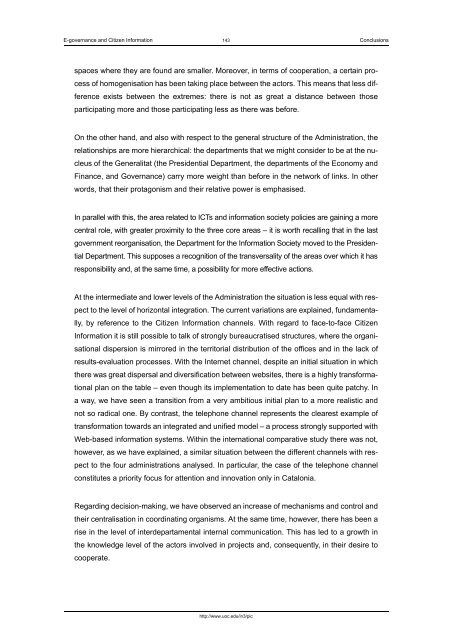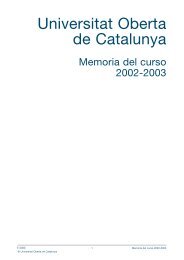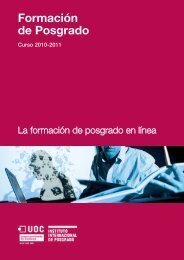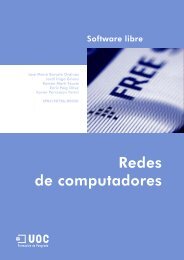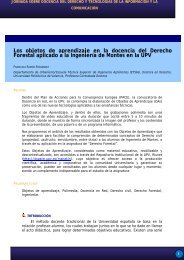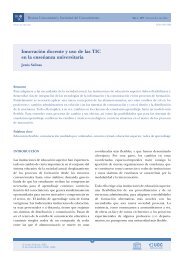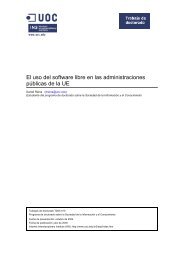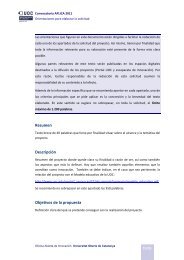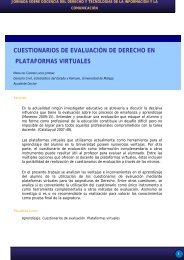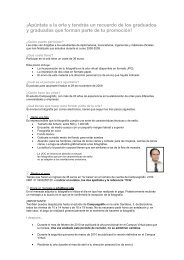e-governance and citizen information - Universitat Oberta de ...
e-governance and citizen information - Universitat Oberta de ...
e-governance and citizen information - Universitat Oberta de ...
You also want an ePaper? Increase the reach of your titles
YUMPU automatically turns print PDFs into web optimized ePapers that Google loves.
E-<strong>governance</strong> <strong>and</strong> Citizen Information 143 Conclusionsspaces where they are found are smaller. Moreover, in terms of cooperation, a certain processof homogenisation has been taking place between the actors. This means that less differenceexists between the extremes: there is not as great a distance between thoseparticipating more <strong>and</strong> those participating less as there was before.On the other h<strong>and</strong>, <strong>and</strong> also with respect to the general structure of the Administration, therelationships are more hierarchical: the <strong>de</strong>partments that we might consi<strong>de</strong>r to be at the nucleusof the Generalitat (the Presi<strong>de</strong>ntial Department, the <strong>de</strong>partments of the Economy <strong>and</strong>Finance, <strong>and</strong> Governance) carry more weight than before in the network of links. In otherwords, that their protagonism <strong>and</strong> their relative power is emphasised.In parallel with this, the area related to ICTs <strong>and</strong> <strong>information</strong> society policies are gaining a morecentral role, with greater proximity to the three core areas – it is worth recalling that in the lastgovernment reorganisation, the Department for the Information Society moved to the Presi<strong>de</strong>ntialDepartment. This supposes a recognition of the transversality of the areas over which it hasresponsibility <strong>and</strong>, at the same time, a possibility for more effective actions.At the intermediate <strong>and</strong> lower levels of the Administration the situation is less equal with respectto the level of horizontal integration. The current variations are explained, fundamentally,by reference to the Citizen Information channels. With regard to face-to-face CitizenInformation it is still possible to talk of strongly bureaucratised structures, where the organisationaldispersion is mirrored in the territorial distribution of the offices <strong>and</strong> in the lack ofresults-evaluation processes. With the Internet channel, <strong>de</strong>spite an initial situation in whichthere was great dispersal <strong>and</strong> diversification between websites, there is a highly transformationalplan on the table – even though its implementation to date has been quite patchy. Ina way, we have seen a transition from a very ambitious initial plan to a more realistic <strong>and</strong>not so radical one. By contrast, the telephone channel represents the clearest example oftransformation towards an integrated <strong>and</strong> unified mo<strong>de</strong>l – a process strongly supported withWeb-based <strong>information</strong> systems. Within the international comparative study there was not,however, as we have explained, a similar situation between the different channels with respectto the four administrations analysed. In particular, the case of the telephone channelconstitutes a priority focus for attention <strong>and</strong> innovation only in Catalonia.Regarding <strong>de</strong>cision-making, we have observed an increase of mechanisms <strong>and</strong> control <strong>and</strong>their centralisation in coordinating organisms. At the same time, however, there has been arise in the level of inter<strong>de</strong>partamental internal communication. This has led to a growth inthe knowledge level of the actors involved in projects <strong>and</strong>, consequently, in their <strong>de</strong>sire tocooperate.http://www.uoc.edu/in3/pic


